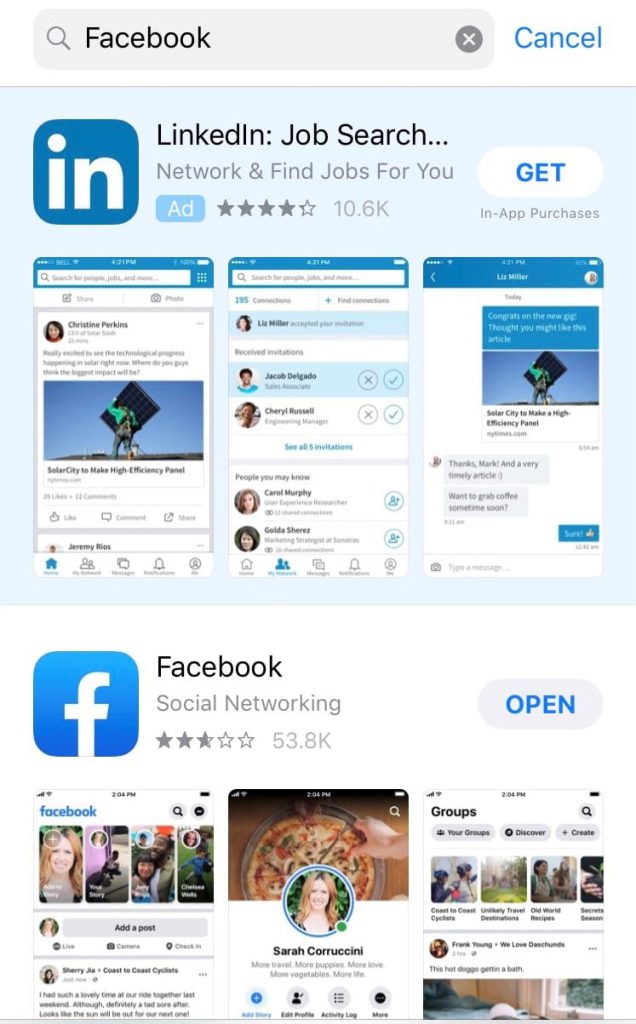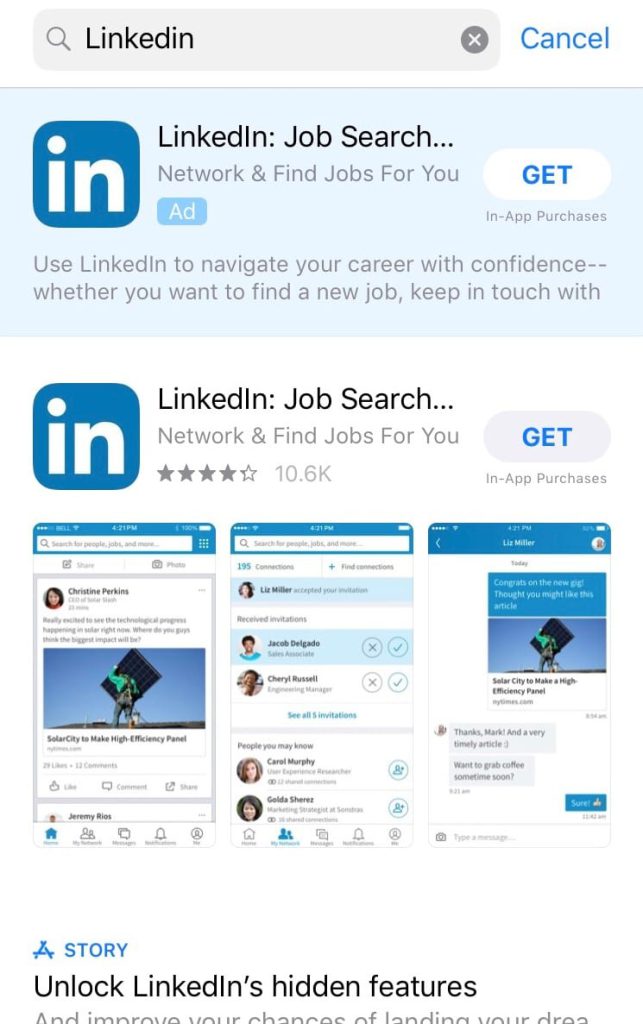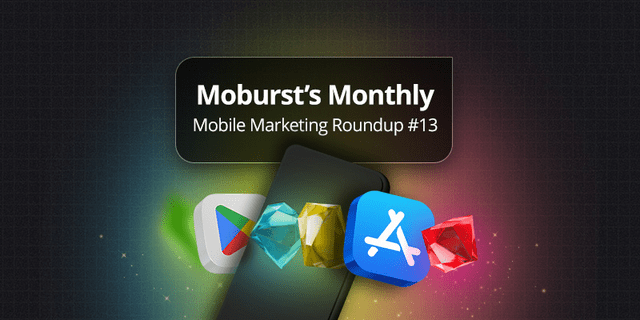
First published on March 9th, 2017.
One of the best mobile marketing channels, Apple Search Ads, can provide an average app conversion rate of about 50%.
Its high conversion rate, higher than its main competitors Facebook Ads and Google Ads, comes from the fact that over 65% of all app downloads are organic with high search intent. Users are searching for relevant app store keywords and encounter apps that they can check out and download.
And right now, the only option to appear above the Apple organic search results, which are influenced by ASO, is to use Apple Search Ads. This is your only chance to appear above branded keywords like Amazon, Uber or Netflix.
Where do Apple Search Ads appear?
Ads are placed above organic search results in the App Store search page and are billed on a pay-per-tap basis.
Similar to Google Play Ads for search, the ads appear on the top of the search results page with a blue-tinted background.
With users acquired through Search Ads, we see lower CPIs (cost-per-install) and higher user retention rates. If you’re looking to advertise to iOS users, you simply cannot ignore this powerful tool.
How do Apple Search Ads work?
Apple Search Ads offers an advanced pricing option based on a Cost-Per-Tap model (CPT), meaning that you pay every time someone clicks on your ad.
The actual cost of a tap is a result of a second price auction, which calculates the CPT you pay based on what your nearest competitor is willing to pay for a tap on their ad, up to your maximum CPT bid.
Apple also allows a cost-per-install bidding model for basic users.
The combination of your app’s relevance to the search query and the amount of your bid will determine whether your ad will be the one shown. (Apple)
For advanced users, Apple offers customization of targeting variables, such as:
- Demographics,
- Location,
- Device type,
- App install status on the user’s device,
- Manual keyword selection, and
- Ad scheduling.
So for example, you can use the campaign to direct users matching specific criteria that are located within a certain distance from your business. You can even ensure the ad appears only during business hours if you so desire.
Why should I use Apple Search Ads?
Between 65-80% of all app installs originate from the App Store search, depending on the niche. This makes Search Ads a particularly effective channel for the acquisition of loyal and engaged users.
According to the Apple Search Ads AppsFlyer tool, Search Ads generates an average of 6 in-app actions per install – the fourth-highest ratio among top media sources.
Why should I use an Apple Search Ads agency?
Managing an Apple Search Ads campaign requires specific expertise that not every Google Ads PPC manager has. Concepts like Share of Voice, Creative Sets and others, are exclusive to SearchAds and need to be managed with great precision. Enter a mobile marketing agency.
In addition to expert knowledge, a mobile agency that offers Search Ads campaign managers also has access to premium tools. Moburst uses AppTweak and several others, which have an annual cost of tens of thousands of dollars. These provide additional insights that can help you make the most of every inch of yohttps://www.moburst.com/mobile-marketing-agency/ur ASA campaign.
The ASA interface is limited. It’s nowhere near as advanced as the much older Google Ads; in-depth insights are hard to come by, and structuring a campaign properly is also quite a different task to Google Ads’.
AppTweak is one of the tools we use for Search Ads intelligence. It has a particularly useful ASA feature that can conduct in-depth competitor analysis. You can:
- Get Share of Voice insights for your app.
- Find keywords that your competitors are bidding for and you’re not.
- Find out if your competitors are targeting your brand name.
MobileAction’s Searchads.com is also a comprehensive tool that helps take ASA campaign management to the next level.
Apple Search Ads Countries
When it first appeared, Apple Search Ads was only available in English speaking countries. It’s now supported in over 59 countries, with Russia being a recent and meaningful addition, on April 27th 2020.
A full list of all the countries available is present on the Apple Search Ads Country page.
Advanced vs Basic
Basic Features:
- A maximum monthly budget of $10,000 per app, per month
- Only cost-per-install (CPI) bidding.
- You can choose your maximum bidding price.
- Apple automates most of your targeting.
Apple Search Ads Advanced features:
- No minimum spend – you can invest as much or as little as you like
- It allows you to use the cost-per-tap (CPT) bidding model.
- It allows you to choose your audience by region, demographics, devices, and keywords.
- You have more control over your campaigns.
If you want to actually boost your app downloads and create relevant ad campaigns, you need to use the Advanced features. Also, with the Advanced package you can provide access to any agency with an Apple ID. That makes it super easy to give Moburst access as your ASA partner when we work together on skyrocketing your Apple Search Ads campaign.
Apple Search Ads Benefits
Cross-Sell & Upsell Opportunities
The advanced package allows you to set Apple Search Ads in the same way that Mobile Facebook ads work. Meaning you can target new users that never installed your app, or users that already know who you are. You can always show ads to existing users in an attempt to persuade them to purchase an upgrade.
You can also use the data you’ve gathered to cross-promote apps. Apple encourages agencies to use the data they have about other apps in order to better promote new ones.
Have you made a campaign around living a healthier lifestyle? You can use the data to also target people that would be interested in workout apps or meditation apps.
ASA Links to your App Rank
The App Store actually takes ads into consideration when it ranks an app. This differs to how website SEO works.
To be more precise, Apple uses relevant key metrics, such as the app conversion rate, app download numbers, etc. to decide if your app should receive a boost in ranking.
There is actually an ad-based ASO strategy that can boost your app ranking. The strategy revolves around launching Search Ads (combined with other mobile ads) to quickly raise the app ranking in less than 48 hours. The strategy is called a “Burst Campaign“.
How to start an Apple Search Ads campaign?
Do your keyword research
There are four main types of keywords:
- Brand keywords: include the app/ company name to grab high-intent users.
- Generic keywords: include descriptive terms relevant to your app to capture new users and raise brand awareness.
- Competitor keywords: include keywords relevant to your competitors to reach new users.
- Discovery keywords: include new relevant keywords using broad keywords Search Match.
These reflect the four main types of campaigns that can be run, as recommended by Apple.
The first three are “exact keywords”, whereas discovery keywords are “broad”. When you bid on a “broad” keyword you’re telling Apple you want to bid on this and other closely related keywords.
Since the announcement of iOS 14 in June 2020 (specifically the spell-check enhancements in the App Store), typos are rendered useless as keywords. There’s now no point in adopting the once popular strategy of placing exact bids on misspelled keywords.
Apple Search Ads has an in-built tool called “keyword popularity index” that allows you to see the amount of traffic received by a particular search term.
It’s super competitive to bid on keywords with search popularity in the top 10%. That’s why you should bid on a range of high and mid popularity keywords, and always test wisely. This means that for a highly competitive keyword like “gambling”, only bid with 90% of your budget. Good results = bid increase. Bad results = pause.
Keep it simple
A competitor analysis is hugely important, but to go live with 300 keywords at once for each campaign both takes a lot of time and can lose you a lot of money. If you target all 300 competitors at once you’ll be spamming your Ads account.
You need to find the balance between deep competitor and generic keywords, beginning with around 25-30 keywords per campaign. This way, you can really find what works and what doesn’t without wasting too much time and money.
As far as choosing the competitors goes, you want to choose the exact competitor that has the most recognized keywords with your brand keywords. The aforementioned tools, e.g. AppTweak & MobileAction, are very helpful here.
Know when to increase and decrease bids
Since ASA is an auction, every bid contributes to the price of the CPT. Apple does give you an indication of whether your bid is strong enough, but this is only the beginning. Then it comes from analyzing data such as conversion rate and cost per acquisition.
When you bid on Facebook or Google for a CPA of $10, usually the algorithm will aim to get you the most valuable users for that price. Once you increase to $12 it will find you the most profitable user for that amount, and so on. However, with ASA, it’s harder to tell how it works backstage.
Consider the following situation: you bid $7 on a keyword and receive many positive results, such as a 50% ROI. Therefore, you decide to increase your bid to $10. After doing so, you notice less actions and revenue despite the higher bid. What we can learn from this is that with ASA a higher bid doesn’t always correlate with better results; this is a process that requires careful attention and monitoring to master.
You need to pay close attention and strike the perfect balance between the bid and the resulting events. We consider it one of the most important KPIs to see the amount of events you’re receiving from a bid.
If you’re seeing good results, you don’t need to make a drastic increase to your bid. Rather, it should be gradual and monitored.
Moburst can help you see the event-per-keyword and recognize trends to help with analysis. On ASA itself you can’t see the event-per-keyword, it’s only visible on external tools such as AppsFlyer or AppTweak that agencies have access to.
So, if you’re an advertiser who wants to launch a new campaign on your own, even if you have an MMP and are certified in using MMPs, and even if you also use the AppsFlyer UI, you won’t necessarily be able to see the events-per-keyword. This is a specific analysis done by agencies like Moburst.
Also, mobile agencies usually have an ASO department like we do. The ASO team can perform analysis before the ASA campaign is launched, much better than any advertiser can do independently. This can involve recognizing trends and discovering valuable keywords. For example, if you have a casino app, you may think that poker is a strong keyword. But you may not know, without the help of an ASO team, that it’s actually incredibly difficult to compete for.
Be careful not to damage ASO
Paid media usually have lower CVR than organic search traffic, because the user intent is lower. A user that is exposed to a banner on Facebook, even if they click, is less likely to engage with the app than a user who is actively searching for an app.
Since CVR is a big factor in determining an app’s organic exposure, either as category ranking or as search-term ranking, it’s important not to let SearchAds campaigns run rampant and damage CVR by introducing high volume, low CTR keywords.
At Moburst, when we run a SearchAds campaign, we make sure that the overall campaign CVR does not lag behind the app’s total CVR or the industry benchmark’s CVR. (How do we know what the industry benchmark is? We use tools.)
Why You Should Consider Branded Keywords for Brand Protection
The jury is still out when it comes to bidding on your own brand name as a keyword in Apple’s App Store. For some, it’s essential for successful campaigns. For others, it’s a waste that makes you pay for traffic you’d have received anyways.
The question is: is it cannibalization or brand protection?
Your Competitors Are Already Doing It
Consider the following real-life scenario: you’ve run Facebook campaigns and retargeted users who have reached a critical point in your marketing funnel.
A user then searches for your app in the App Store (and remember, the most-searched terms are majority brand names – over 50% in fact) but a competitor of yours has bid for your brand name, resulting in them receiving the coveted top spot in the App Store search results. This quite possibly allows them to ride into the sunset with “your” hard earned user.

If you don’t bid on your branded keywords at the same time as your competitor bids on them, their app will appear above yours in the organic listing too. Not only have they probably got the paid ad, but they’ve probably bumped you out of your top organic place as well.
It isn’t a great reflection on your company and its marketing strategy if the “top” result, even when searching for your specific brand name, is of a rival app.
So, by bidding on your own app name as a keyword, rather than cannibalizing you’re actually protecting your brand from sneaky competitors piggybacking off your success. You’re both preventing them from stealing your users and ensuring that your app ranks first almost every time your app name is searched in the app store.
You Have Little To Lose
With a user searching for your brand, and assuming your ASO is good enough that you’d have come up as the top result (we can help you there), are you paying for a tap that you would have received organically?
The good news is this: Since ads are presented in a shorter format than organic results, the user will generally be drawn to click on your organic app listing because it has more information, screenshots, and so on – saving you money. Usually, if the ad and first organic app for a particular keyword are the same, Apple only shows a text ad, which takes up even less space. So you don’t need to worry about cannibalization.

Alternatively, if you’re outbid by a competitor because it’s not financially feasible for you to pay more (this kind of decision will be impacted by metrics such as LTV), then you’ve always got your awesome ASO to fall back on. Consider the scenario where your competitor has the top (paid) spot, but immediately underneath is your app, complete with incredible creative assets from screenshots to video. Like we said, the user will likely be drawn here due to the extra information.
Work with your Apple Search Ads Creative Sets
“Apple Creative sets” is a feature that was integrated in 2018.
It allows publishers to modify the way creatives are integrated inside the Search Ads, allowing users to test and tweak both ads and organic variants alike.
While you can’t really A/B test organic creatives using Search Ads, you can use the Apple Creative Sets to better understand what combination of creative has a higher conversion rate.
The creative set works by allowing you to choose between the images and videos already present on the app’s page.
Apple Search Ads Creative Set Limitations
Only screenshots that have been uploaded to the store can be used. So, to refresh creative materials and ads, you must push a new app update.
The order in which the screenshots will be uploaded to the App Store will dictate the available order of creatives in the Creative Set, which is not necessarily what we want. Ordinarily, the ability to mix and match, as well as to test different ad combinations, is crucial for advertisers to determine which are working best and should be kept alive and which shouldn’t.
Perhaps the biggest difficulty when working with this new tool is the reporting feature. As it’s not possible to see a combination of creative and relevant keywords together, it becomes nearly impossible to know what works best on the keyword level.
The feature will enable advertisers to better control the creatives as much as possible in other platforms (albeit with lots of limitations), and help to increase the CTR and CVR (TTR and CR in Apple lingo), by using more targeted creatives for each campaign/ ad group.
The A/B Testing aspect of Creative Sets
Creative sets can also assist with App Store creative A/B testing, i.e. not through third party solutions such as StoreMaven or SplitMetrics.
To date, there wasn’t an option to test App Store creative assets with organic search traffic, similar to the option to test on Google Play through its Experiments module.
While not designed to be an A/B test tool, Creative Sets provide the opportunity to gain unique insights into App Store user behavior, not to mention the ability to test the performance of creative per keyword.
ASA vs. GPE vs. AB platforms
| Google Play Experiments | Apple Search Ads | A/B Test Platforms | |
| Traffic Price | free | expensive | medium |
| Live Store Traffic | yes | yes | no |
| Stats | poor | medium | excellent |
Don’t forget about Apple Search Ads API
The Apple Search Ads Attribution API is a line of code that can be easily installed into any app, integrated into the Xcode project file of the app. It’s crucial for all multi-channel marketing campaigns. It can also be linked with most analytics tools on the market.
By integrating the script inside your app, you can understand which channel or medium has brought installs and conversions in your app.
You can use the API information to optimize your CPT and CPA targets, understand campaign ROI, user lifetime value (LTV) and effectiveness of your advertising campaigns.
Conclusions
Apple Search Ads are one of the best ways to increase app downloads on the iOS App Store.
Make sure you plan everything ahead, do your research and A/B test with the Apple Creative Sets. You could even get in touch with a mobile marketing agency while you’re at it.








